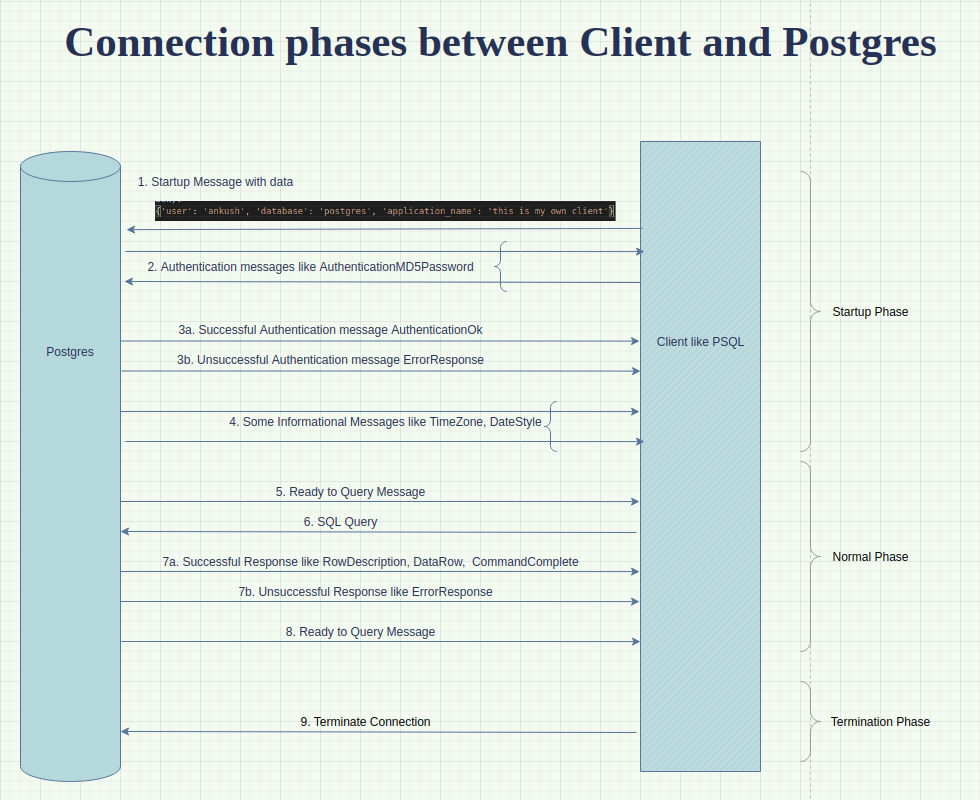Understanding Postgre's Wire Protocol
Introduction to Postgres Wire Protocol
Postgres uses Message based protocol to comunicate between clients( for eg. psql) and DB server.
I will try to summarize some aspects of the protocol.
- Current version is 3.0
- Supports TCP/IP and Unix domain sockets (IPC Sockets).
- Each connection goes through 3 phases -

Startup Phase
- Client opens connection by sending startup message ( See 1 in the figure above )
- The structure of a startup message is as follows -
| 4 byte | 4 bytes | |
|---|---|---|
| Length of message | Protocol Version | Message Data like username, database name etc |
- Server checks the message data from above and also its own config files, to determine the response, which can be one of the following -
- A success response (
AuthenticationOk) ( 3a in the figure ) - An error response (
ErrorResponse) ( 3b in the figure ) - Authentication related messages( like
AuthenticationMD5Password) - Protocol negotiation response (
NegotiateProtocolVersion)
- A success response (
- If the response was
AuthenticationOkthen server sends some more messages( 4 in the figure ), but the most important of them isReadyForQuerymessage( 5 in the figure ). Once sent, the next phase (Normal phase) is initiated. - Server launches a new process for each client connection.
- Also interestingly, other than the startup message, the message format is
| 1 byte | 4 bytes | |
|---|---|---|
| Message Type | Length of message | Message Data depending on Message Type |
Operations in Normal Phase
- Client sends query message and Server responds accordingly.
- When server parses the query, it does the following steps -
- Parse step which creates a prepared statement from a textual query. It may have a name, in which case it can be reused multiple times, hence optimizing response times. This step can be done manually using
PREPARESQL. - Bind step which creates a portal given a prepared statement (from step 1) and values for any parameters. Again, it may have a name as well. Query planning happens after this step completes. Can be done by SQL
CREATE CURSORandFETCH. - Execute step which runs the portal’s query. Also can be called manually by SQL
EXECUTE. - Sync step which completes the query transaction.
- Parse step which creates a prepared statement from a textual query. It may have a name, in which case it can be reused multiple times, hence optimizing response times. This step can be done manually using
- Query can use either of 2 sub-protocols -
- A simple query protocol in which only a textual SQL query is sent.
- Backend creates an unnamed prepared statement, portal and executes it.
- It then responds with one or more response messages, finally ending the response with
ReadyForQueryMessage. - Interestingly, if the query contains multiple SQL statements ( seperated with a
;), aCommandCompleteis sent after each statement is executed. HoweverReadyForQueryis only issued after all queries are completed. If there is any error raised in any one of them, all the statements are rolled back, firstErrorResponseis responded followed by aReadyForQuery - Also, there is no need for client to wait for
ReadyForQueryand can send further queries if it wants.
- An Extended Query Protocol does the 3 steps as seperate statements.
- For response of Parse step,
ParseCompleteresponse is sent. - For response of Bind step,
BindCompleteresponse is sent. - For response of Execute step,
CommandCompleteresponse is sent. - For response of Sync step,
ReadyForQueryresponse is sent. - Important to note that it cannot parse multiple SQL statements, unlike Simple Query protocol.
- A Sync needs to be sent everytime to end a transaction.
- However, one can send multiple Bind and Execute messages, for same portal without waiting for
ReadyForQuery.- A web application can use this feature to get async responses of its queries.
- For response of Parse step,
- A simple query protocol in which only a textual SQL query is sent.
- One important caveat is that a prepared statement cannot be shared between different processes / connections. It only lives for 1 session.
- Checkout my pg-client implementation script here
Termination Phase
- Normally initiated by client
- Server responds and roll backs any incomplete transactions.
Sources -